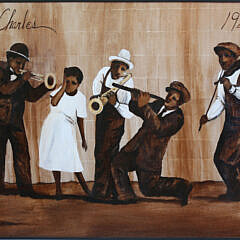Molly Dee (American, b. Buffalo, NY; 1938-2022)
Sepia, a pigment derived from the common cuttlefish, has been used for over a century. It was originally used by photographic toners to increase the range of visible shades in a black & white image without reducing contrast. Sepia is a color gradient, absent of color, apart from its characteristic, warm umber. Contrary to the chiaroscuro techniques favored during the Renaissance, where modeling light sharply against dark suggested volume, sepia used as toner diffuses the sharp, two dimensional edges between painted light and shadow, the softness evoking vintage and nostalgia.
Molly Dee the Romanticist paints in sepia tone to evoke an entirely personal, immediate, familiar and pleasantly emotional response. Molly Dee the Minimalist uses sepia tone to diminish the volume in human forms against land or sea ‘scapes, diverting the viewers attention to mood. Molly Dee the Figurative painter prefers sepia tone to animate body language and unspoken expressions among her subject gatherings. Hers is a modernist voice applied to a traditionalist vocabulary.
American painter, Molly Dee was born in Buffalo, NY in 1938. Studying at the acclaimed Albright Knox Art School, she received her Bachelor of Fine Arts Degree in 1960 from the University of Buffalo. Work for her Masters of Art Degree in 1973 and subsequent graduate studio work was done at the State University of New York at Buffalo.
Old photographs garnered from estate sales, family collections and historical archives are the inspiration for Molly’s large figurative paintings. Her unique style and interpretation of photographic images evolved from the artist’s early fascination with photos of her own parents, whom she had never known…
…Dee’s work is large in scale and profound in impact; now widely collected by both individuals and corporations world wide.” Rider Frames & Gallery
Recent Examples at Auction










- Joan Albaugh
- Ethel Anderson
- William D. Appleton
- Clifford Warren Ashley
- John Austin
- Milton Avery
- Solon Francis Montecello Badger
- James Francis Barker
- Doris & Richard Beer
- Eugene Louis Boudin
- Alfred Thompson Bricher
- Albert Bross
- Robert Bushong
- Polly Bushong
- James Edward Buttersworth
- Ralph Eugene Cahoon
- Martha Cahoon
- Nikita Carpenko
- Lincoln J. Ceely
- Frederick S Chadwick
- Rodney Charman
- Frank Swift Chase
- Leander M Churbuck
- Elizabeth Rebecca Coffin
- Anne Ramsdell Congdon
- Colin Campbell Cooper
- Laura Cooper
- Mellie Cooper
- Frank Corso
- James Cromartie
- Roy Cross
- Vu Cao Dam
- William R. Davis
- Gene Davis
- Molly Dee
- Donald Demers
- John Devaney
- William Duffy
- Lawrence Charmichael Earle
- Henry Stephens Eddy
- Alan J. Eddy
- Virginia Bargar Evans
- José Fabri-Canti
- John Falato
- George Gardner Fish
- Annie Barker Folger
- James Walter Folger
- Stephen Gibbs
- André Gisson
- Sybil Goldsmith
- Emile Albert Gruppe
- Marilyn Guerinot
- Mauritz Frederik Hendrick de Haas
- Davis Hall
- Kerry Hallam
- James Harrington
- James Hathaway
- Lowell Herrero
- Jason Emerson Herron
- Philip Hicken
- George Frank Higgins
- G.S. Hill
- Megan Hinton
- Emily Hoffmeier
- Alfred Heber Hutty
- George Inness
- Antonio Nicolo Gasparo Jacobson
- Edgar W. Jenney
- Theodore Jeremenko
- Eastman Johnson
- Illya Kagan
- Michael Keane
- William Keith
- David Kooharian
- Kenneth Layman
- David Lazarus
- George Lear
- Richard Hayley Lever
- John Lochtefeld
- Harriet Lord
- Richard Loud
- William W. Lowe
- Michael Lynch
- William Starbuck Macy
- William Ferdinand Macy
- Wendell Macy
- Aletha Macy
- George Herbert McCord
- Keith McDaniel
- Joseph McGurl
- Maggie Meredith
- Addison Thomas Millar
- Jan L. Munro
- Mary Sarg Murphy
- Mark Myers
- Tom Nicholas
- Reginald Eugene Nickerson
- Michael A. Palmer
- Margaret Jordan Patterson
- Jan Pawlowski
- Edgar Payne
- C. Robert Perrin
- Helen Sharp Potter
- Jane Brewster Reid
- José Formoso Reyes
- Volney Allan Richardson
- Forrest Anderson Rodts
- Sergio Roffo
- Lenka Rubenstein
- Elizabeth Saltonstall
- Andrew Jackson Sandsbury
- Tony Sarg
- Issac Sheffield
- Andrew Shunney
- Henry Pember Smith
- Lillian Gertrude Smith
- H. Stadler
- Richard Stalter
- Robert Stark Jr.
- William Pierce Stubbs
- Mara Superior
- Ruth Haviland Sutton
- Ferdinand Sylvaro
- Anthony Thieme
- Tim Thompson
- Roy Tidmarsh
- Yasemin Tomakan
- Katie Trinkle-Legge
- Isabelle Hollister Tuttle
- Emma H. Van Pelt
- William Welch
- Orrin Augustine White
- Paul Whitten
- Paul Willer
- Sid Willis
- Bert Wright
- James Wyer
- Julian E. Yates
- Lori Zummo

![dee[1]](https://dn9ml16rd2hb8.cloudfront.net/2014/04/dee1.jpg)